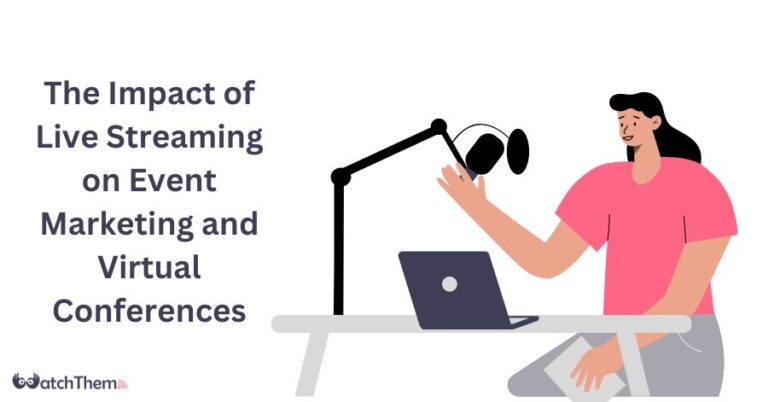Page Contents
As a result of the proliferation of live streaming technologies in recent years, the landscape of event marketing and conferences has experienced considerable upheaval.
Livestreaming has completely altered how organizations interact with their audiences. This business strategy has made it possible for them to communicate with people all over the world in real-time and to extend the reach of their events beyond the confines of physical space.
Throughout this piece, we will investigate the significant influence that live streaming has had on event marketing and virtual conferences.
Breaking Down Geographic Barriers
‘When it comes to event marketing, the capacity of live streaming to break down geographical borders is one of the most significant advantages. Livestreaming enables companies to communicate with participants located in different parts of the world, making it possible for them to take part in events and conferences regardless of where they are physically located.


New prospects for broadening the audience reach and increasing interaction on a worldwide scale are made available as a result of this.’ – Richard Skeoch, Director at Hyperion Tiles
Enhancing Accessibility and Inclusivity
‘Through the use of live-streaming technology, events, and conferences have become more accessible and inclusive than they have ever been without. Organizations can accommodate persons who may not be able to attend events in person due to travel restrictions, impairments, or other limits by livestreaming the activities.
An inclusive environment is fostered as a result of this, and it guarantees that a wide variety of attendees will have access to the insightful content and information that will be presented throughout the event.’ – Mark McShane, Digital PR Agency Owner, Cupid PR
Increasing Audience Engagement
‘The ability to communicate and engage with the audience in real-time is made possible by live streaming, which adds a dynamic element to event marketing. Participants have the opportunity to take part in live question-and-answer sessions, surveys, and conversations, which helps to cultivate a sense of community and involvement.
Additionally, live streaming makes it possible for the audience to provide quick feedback and reactions, which results in an experience that is more dynamic and engaging for all of the participants.’ – Eric Lam, Head of Business Strategy at Los Angeles Tax Appeal
Extending the Lifespan of Events
‘Unlike traditional in-person events, which often only last for a short period, live-streamed events have the potential to continue for a much longer period after the first broadcast. Through the process of repurposing live-streamed information, organizations can transform it into on-demand videos, webinars, and social media posts, which enables them to increase their audience over time.
To ensure that valuable material continues to provide value long after the event has concluded, this not only maximizes the return on investment for the event but also ensures that the event itself continues to provide value.’ – Tim Parker, Director at Syntax Integration
Driving Brand Awareness and Visibility
‘There is great potential for businesses to significantly improve their brand exposure and visibility by livestreaming events and conferences. Organizations can both boost their visibility within the business and position themselves as thought leaders if they broadcast their events to an audience that is located all over the world.
Livestreamed events also create opportunities for sponsors and partners to receive exposure and reach new audiences, which further amplifies the visibility and recognition of the brand.’ – Henry Allen, Digital Marketing Manager at Loyalty Lion
Cost-Effectiveness and Scalability
‘Livestreaming provides a solution for event marketing that is both more cost-effective and scalable than the traditional in-person events that are traditionally held. Through the use of live streaming, organizations can cut costs associated with venue rents, travel, hotels, and logistics.
Additionally, live streaming enables scalability, which enables companies to accommodate a greater number of guests without being constrained by the restrictions of physical space.’ – Mike Johnson, CMO of Great Homeschool Conventions
Gathering Valuable Data and Insights
‘The data and insights that are provided by live-streaming platforms to organizations are extremely useful and can be used to guide future event marketing initiatives. Organizations can get insights into the preferences and behaviors of their audiences by tracking indicators such as viewer demographics, engagement levels, and viewer retention rates.
This data can be utilized to increase the overall success of event marketing, as well as to optimize future events, customize material to the interests of the audience, and optimize subsequent events.’ – Andy Fryer, Co-Founder of Easy Signs
Adapting to Changing Consumer Behavior
‘The use of live streaming has become an indispensable instrument for businesses that are attempting to adjust to shifting patterns of consumer behavior in a world that is becoming increasingly digital. Livestreaming provides audiences with a comfortable and easily accessible option to participate in events and conferences from any location and at any time.
This is especially important in light of the growing prevalence of remote work and virtual contacts. Through the adoption of live streaming technology, enterprises can maintain a competitive advantage and fulfill the ever-evolving requirements and anticipations of their audience.’ – Jessica Shee from iBoysoft
Also Read: Customer Behavior Analytics
FAQs
In case you have any more questions left, here are some frequently asked questions to help you out!
Q1. What Are the Benefits of Live Streaming for Event Marketing?
Live streaming offers several benefits for event marketing, including reaching a global audience, making events more accessible and inclusive, fostering audience engagement in real-time, extending the lifespan of events through repurposing content, enhancing brand awareness and visibility, providing a cost-effective and scalable solution, gathering valuable data and insights for future initiatives, and adapting to changing consumer behavior in a digital world.
Conclusion
In conclusion, the technology of live streaming has had a significant impact on event marketing and virtual conferences, thereby altering how companies communicate with their consumers.
In the realm of event marketing, livestreaming presents a multitude of advantages, including the elimination of geographical obstacles and the enhancement of accessibility, as well as the enhancement of audience engagement and the advancement of brand awareness.
Those companies that embrace this technology will be in a strong position to achieve success in the digital age of event marketing and conferences. Livestreaming is continuing to develop and is becoming increasingly integrated into event strategy.

